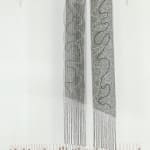Vivian Caccuri
Pagode Igarapé, 2020
barra de ferro, tela mosquiteiro, cordão de nylon, linhas de algodão e ponta de grade de alumínio
[iron bar, mosquito net, nylon cord, cotton threads and aluminum gate spearheads]
[iron bar, mosquito net, nylon cord, cotton threads and aluminum gate spearheads]
235 x 156 x 52 cm
[92 1/2 x 61 3/8 x 20 1/2 in]
9.5 kg
[92 1/2 x 61 3/8 x 20 1/2 in]
9.5 kg
Further images
-
(View a larger image of thumbnail 1
)

-
(View a larger image of thumbnail 2
)

-
(View a larger image of thumbnail 3
)

-
(View a larger image of thumbnail 4
)

-
(View a larger image of thumbnail 5
)

-
(View a larger image of thumbnail 6
)

-
(View a larger image of thumbnail 7
)

-
(View a larger image of thumbnail 8
)

-
(View a larger image of thumbnail 9
)

Os trabalhos 'História do Arco', 'A Woman's Work' e 'Igarapé', fazem parte da pesquisa que a artista chamou de 'Pagodes', série de telas plásticas desfiadas e bordadas que começou em...
Os trabalhos "História do Arco", "A Woman's Work" e "Igarapé", fazem parte da pesquisa que a artista chamou de "Pagodes", série de telas plásticas desfiadas e bordadas que começou em 2014. A relação direta entre instrumentos musicais e o hábito carnívoro de diversas sociedades é uma fonte de inspiração para "História do Arco": nesta tela, harpas estão sangrando e uma arqueira atira uma seta. É em um encontro pictórico do arco-e-flecha com a harpa, entendendo que o primeiro deu origem ao segundo. O sangue é simulado com tranças de lã vermelha que criam um efeito do escorrimento também em "A Woman's Work". Inspirado na canção de mesmo nome da cantora e compositora britânica Kate Bush, este pagode mostra um piano de cauda desenhado em tamanho real, que sangra. As pontas e setas, próprias da cultura da caça e da guerra, e depois incorporadas à arquitetura urbana, servem de sinos ("chimes") que com o movimento, balançam e tocam um som doce e metálico.
[The works "História do Arco", "A Woman's Work" and "Igarapé", are part of the research that the artist called "Pagodes", a series of shredded and embroidered plastic canvases that began in 2014. The direct relationship between musical instruments and the carnivorous habit of several societies is a source of inspiration for "History of the Arch": on this canvas, harps are bleeding and an archer shoots an arrow. It is in a pictorial encounter of the bow and arrow with the harp, understanding that the first gave rise to the second. The blood is simulated with red wool braids that also create a dripping effect in "A Woman's Work". Inspired by the song of the same name by British singer and songwriter Kate Bush, this pagoda shows a full-size, bleeding grand piano. The tips and arrows, typical of the culture of hunting and war, and later incorporated into urban architecture, serve as bells ("chimes") that with movement, swing and play a sweet and metallic sound.]
[The works "História do Arco", "A Woman's Work" and "Igarapé", are part of the research that the artist called "Pagodes", a series of shredded and embroidered plastic canvases that began in 2014. The direct relationship between musical instruments and the carnivorous habit of several societies is a source of inspiration for "History of the Arch": on this canvas, harps are bleeding and an archer shoots an arrow. It is in a pictorial encounter of the bow and arrow with the harp, understanding that the first gave rise to the second. The blood is simulated with red wool braids that also create a dripping effect in "A Woman's Work". Inspired by the song of the same name by British singer and songwriter Kate Bush, this pagoda shows a full-size, bleeding grand piano. The tips and arrows, typical of the culture of hunting and war, and later incorporated into urban architecture, serve as bells ("chimes") that with movement, swing and play a sweet and metallic sound.]








